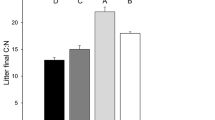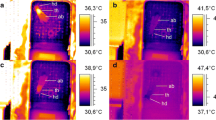Summary
Experiments were done to measure the respiration rates of twenty species of terrestrial snail. Acclimatization phenomena were sought in two species, Discus rotundatus and Hygromia striolata, but not detected. The Q 10s between 5 and 15° C for the twenty species varied between 1.20 and 4.27, with a mean Q 10 of 2.21. Q 10 was higher in larger snail species. There was an increase in respiration with body weight for those species which grew to a large size, but the trend was not detectable in species with small adult weight. A double log plot of mean respiration rate of each species against the mean weight of each species gave a linear relationship.
Mean monthly leaf litter temperature was measured in a beech woodland site in Wytham Woods, Berkshire. Litter temperature, in combination with snail population data and size class distribution, was used to calculate population metabolism of the snails on the site. Annual population metabolism amounted to 7.0934 kcals/m2/annum. The estimated annual production was 4.4386 kcals/m2. The P/R ratios varied between 0.143 and 1.861, P/B ratios varying from 1.0 to 34.3. From the data it is suggested that respiration alone will not give a good measure of the importance of different species in litter breakdown.
Similar content being viewed by others
References
Åkerlund, G.: Oxygen consumption of the ampullariid snail, Marisa cornuarietis L. in relation to body weight and temperature. Oikos 20, 529–533 (1969).
Berg, K., Ockelmann, K. W.: The respiration of freshwater snails. J. exp. Biol. 36, 690–708 (1959).
Berthet, P.: La mesure écologique de la température par détermination de la vitesse d'inversion du saccharose. Vegetatio 9, 197–207 (1960).
Bullock, T. H.: Compensation for temperature in the metabolism and activity of poikilotherms. Biol. Rev. 30, 311–342 (1955).
Daniels, J. M., Armitage, K. B.: Temperature acclimation and oxygen consumption in Physa hawnii Lea (Gastropoda: Pulmonata). Hydrobiologia 33, 1–13 (1969).
Engelmann, M. D.: Energetics, terrestrial field studies, and animal productivity. Adv. ecol. Res. 3, 73–116 (1966).
Fischer, P. H., Duval, M.: Note préliminaire sur les échanges respiratoires de l'escargot. Ann. physiol. physicochim. biol. 7, 88–93 (1931).
Golley, F. B.: Energy dynamics of a food chain of an old-field community. Ecol. monogr. 30, 187–206 (1960).
Healey, I. N.: The energy flow through a population of soil Collembola. (Secondary productivity of terrestrial ecosystems, ed. K. Petruzewicz), p. 695–708. Warsaw: Panstwowe Wydownicwo Nanltowe 1967.
Kienle, M. L., Ludwig, W.: Die Beziehung zwischen Körpergröße und Sauerstoffkonsum bei Landpulmonaten. Z. vergl. Physiol. 39, 102–118 (1956).
Lawton, J. H.: Studies on the ecological energetics of damselfly larvae (Odonata: Zygoptera). Ph. D. Thesis, University of Durham (1969).
Liebsch, W.: Über die Atmung einiger Heliciden. Eine Untersuchung zum Oberflächengesetz. Zool. Jb. Abt. allg. Zool. u. Physiol. 46, 161–208 (1929).
Macfadyen, A.: Methods of investigation of productivity of invertebrates in terrestrial ecosystems. (Secondary productivity of terrestrial ecosystems, ed. K. Petrusewicz), p. 383–412. Warsaw: Panstwowe Wydownicwo Naukowe 1967.
Mason, C. F.: Food, feeding rates and assimilation in woodland snails. Oecologia 4, 358–370 (1970a).
—: Snail populations, beech litter production, and the role of snails in litter decomposition. Oecologia 5, 215–239 (1970b).
Mason, C. F. Bio-energetic studies of populations of woodland molluscs. D. Phil. Thesis, University of Oxford (1970c).
McNeil, S., Lawton, J. H.: Annual production and respiration in animal populations. Nature (Lond.) 225, 472–474 (1970).
Müller, I.: Die Abhängigkeit des Stoffwechsels von der Körpergröße und der Zusammenhang von Stoffwechseltypen und Wachstumstypen. Riv. Biol. 35, 48–95 (1943).
Phillipson, J.: The use of respiratory data in estimating annual respiratory metabolism, with particular reference to Leiobunum rotundum (Latr.) (Phalangida). Oikos 14, 212–223 (1963).
Ralph, C. L.: Persistent rhythms and oxygen consumption in the earthworm. Physiol. Zool. 30, 41–55 (1957).
Rao, K. P., Bullock, T. H.: Q 10 as a function of size and habitat temperature in poikilotherms. Amer. Naturalist 88, 33–44 (1954).
Richards, J: Pers comm. (1970).
Segal, E.: Acclimation in molluscs. Amer. Zool. 1, 235–244 (1961).
Teal, J. M.: Respiration of crabs in Georgia salt marshes and its relation to their ecology. Physiol. Zool. 32, 1–14 (1959).
Wieser, W.: Untersuchungen über die Ernährung und der Gesamtstoffwechsel von Porcellio scaber (Crustacea: Isopoda). Pedobiologia 5, 304–331 (1965).
Author information
Authors and Affiliations
Rights and permissions
About this article
Cite this article
Mason, C.F. Respiration rates and population metabolism of woodland snails. Oecologia 7, 80–94 (1971). https://doi.org/10.1007/BF00346295
Received:
Issue Date:
DOI: https://doi.org/10.1007/BF00346295




